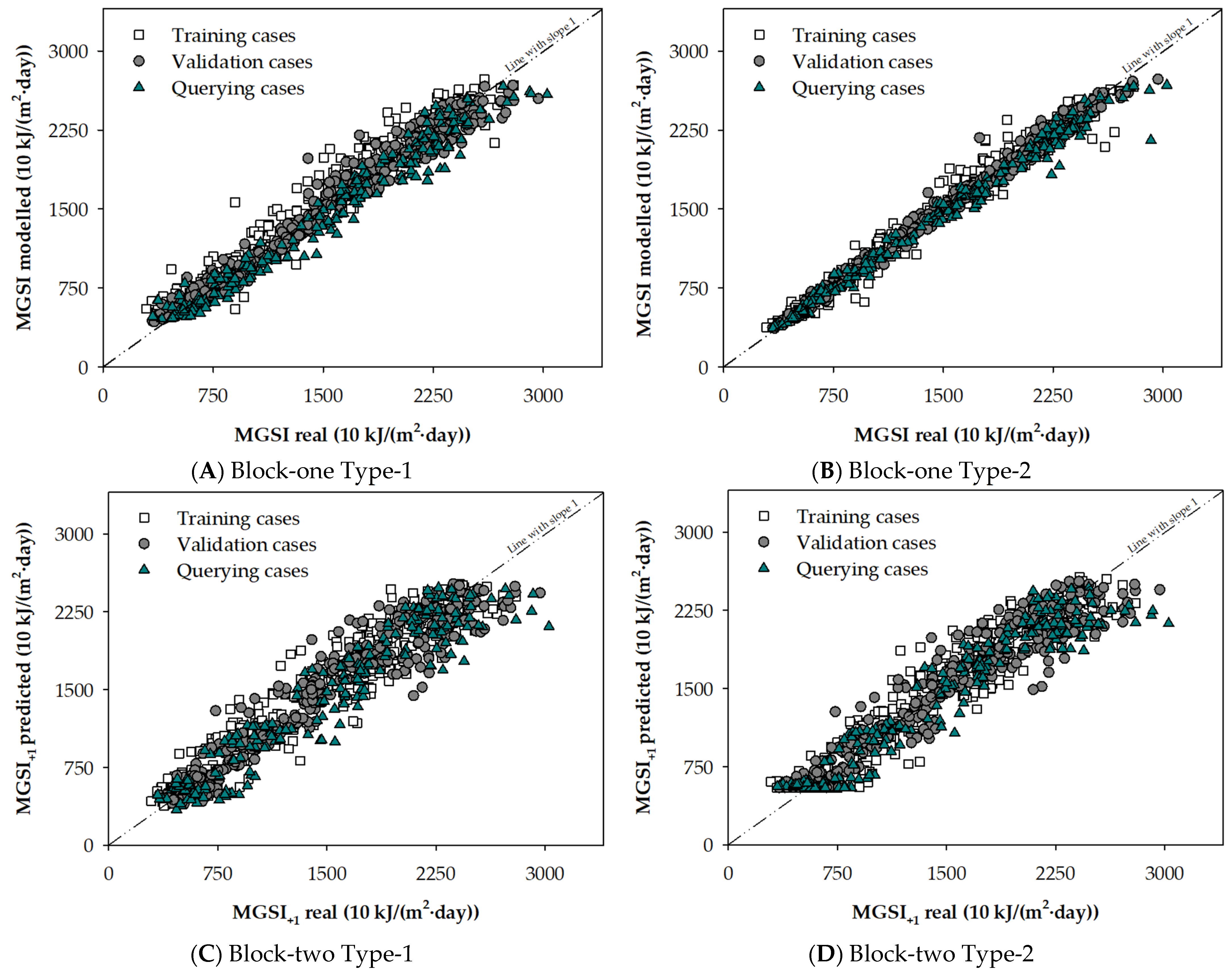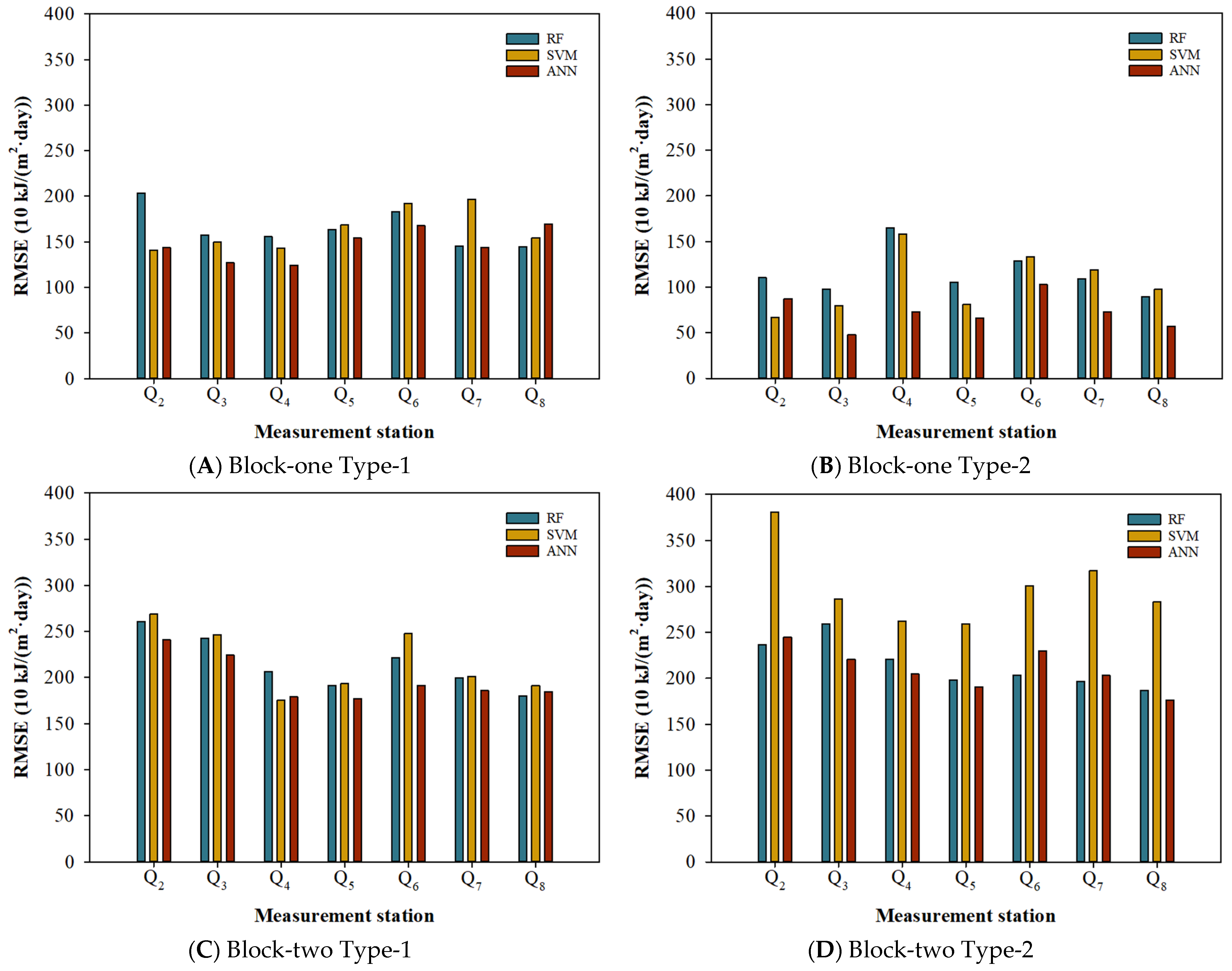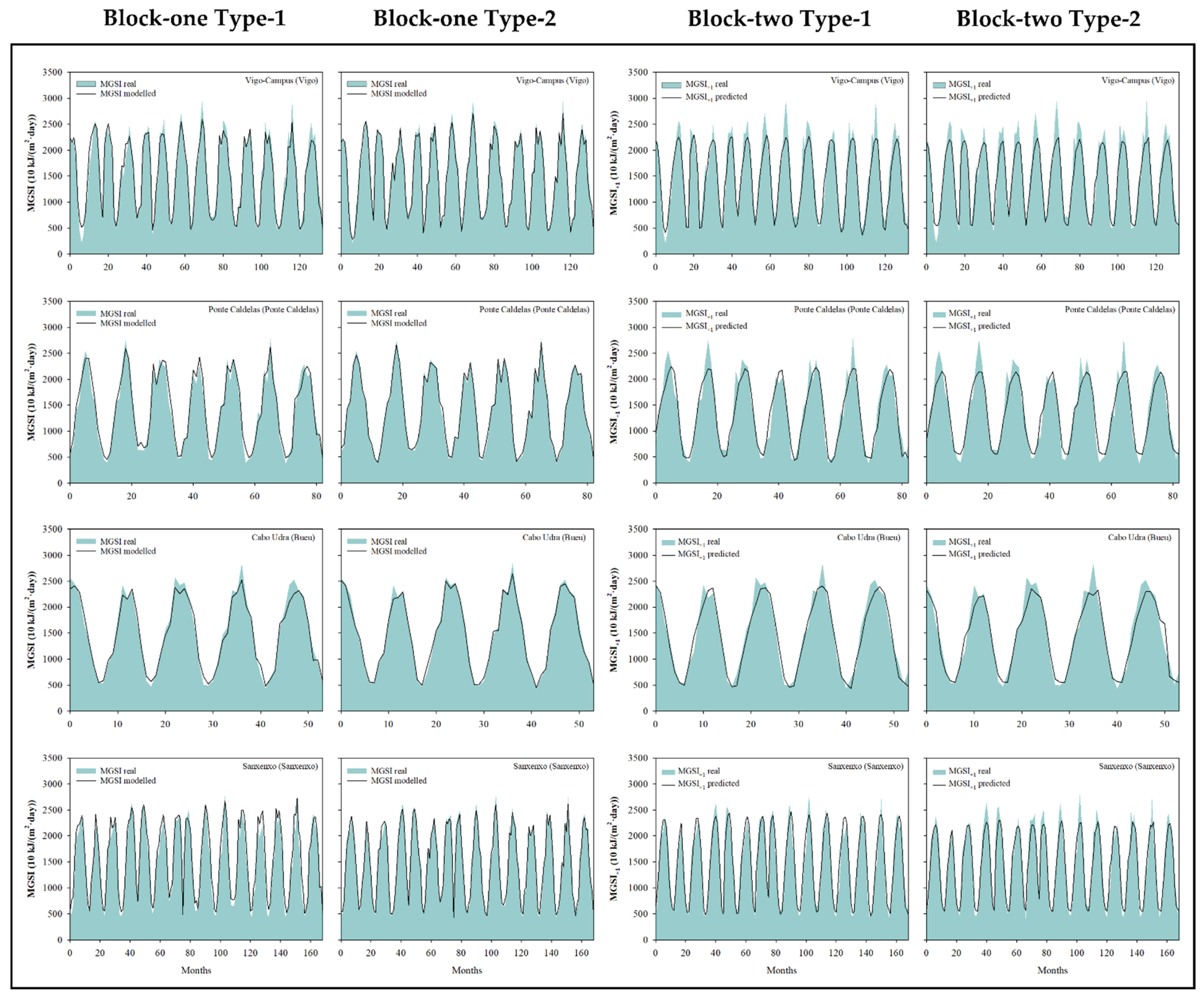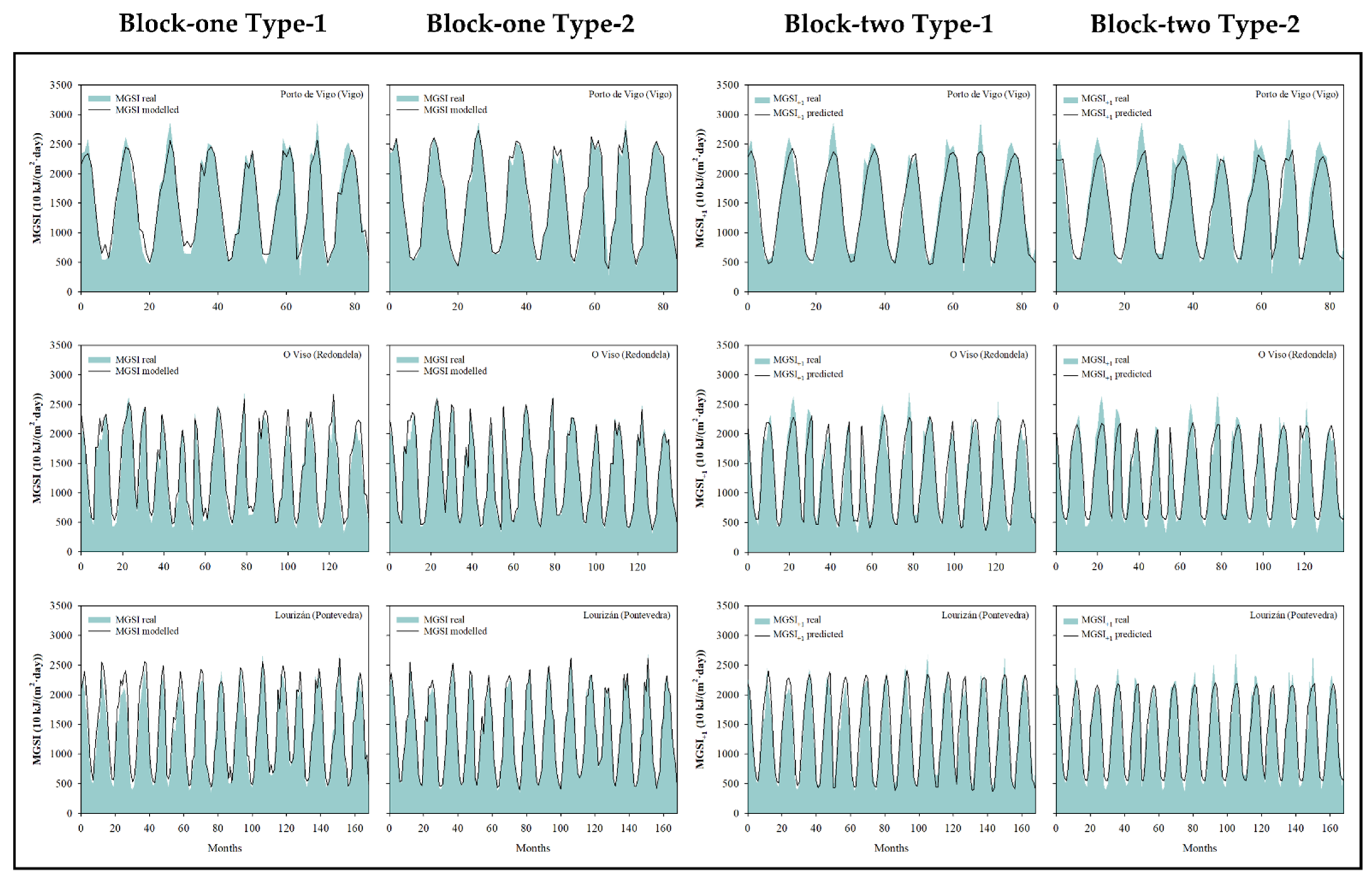Global Solar Irradiation Modelling and Prediction Using Machine Learning Models for Their Potential Use in Renewable Energy Applications
Abstract
1. Introduction
- In environmental science to predict metal immobilisation remediation through the use of biochar amendment in soil using different variables such as biochar characteristics or soil physiochemical properties, among others [12], or to predict different important parameters in the Mediterranean Sea [13].
- In agricultural science in industrial hemp crops to optimise in vitro germination and growth indices [16].
2. Materials and Methods
2.1. Study Area
2.2. Database
2.3. Model Implementation
2.3.1. Variable Combinations
2.3.2. Models Implemented
Random Forest Models
Support Vector Machine Models
Artificial Neural Network Models
2.4. Statistics
2.5. Equipment and Software Used
3. Results and Discussion
3.1. Approaches to Modelling Monthly Global Solar Irradiation (Block-One)
3.2. Approaches to Predicting the Monthly Global Solar Irradiation One Month Ahead (Block-Two)
3.3. Generalisation at Different Locations
3.4. Final Remarks—Analysis of the Models via a Database Update
4. Conclusions
Author Contributions
Funding
Institutional Review Board Statement
Informed Consent Statement
Data Availability Statement
Acknowledgments
Conflicts of Interest
Nomenclature
| AI | Artificial intelligence |
| ANN | Artificial neural network |
| Block-one | Group of ML approaches developed to model the MGSI |
| Block-two | Group of ML approaches developed to predict the MGSI+1 |
| LSTM | Long short-term memory |
| MAPE | Mean absolute percentage error |
| MGSI | Monthly global solar irradiation |
| MGSI+1 | Monthly global solar irradiation one month ahead |
| ML | Machine learning |
| MLP | Multilayer perceptron |
| Q | Querying phase |
| Q2 | Querying phase for Vigo-Campus station (Vigo) |
| Q3 | Querying phase for Ponte Caldelas station (Ponte Caldelas) |
| Q4 | Querying phase for Cabo Udra station (Bueu) |
| Q5 | Querying phase for Sanxenxo station (Sanxenxo) |
| Q6 | Querying phase for Porto de Vigo station (Vigo) |
| Q7 | Querying phase for O Viso station (Redondela) |
| Q8 | Querying phase for Lourizán station (Pontevedra) |
| r | Correlation coefficient |
| RF | Random forest |
| RMSE | Root mean square error |
| SVM | Support vector machine |
| T | Training phase |
| Type-1 | Variable combination Type-1 |
| Type-2 | Variable combination Type-2 |
| V | Validation phase |
References
- Diez, F.J.; Navas-Gracia, L.M.; Chico-Santamarta, L.; Correa-Guimaraes, A.; Martínez-Rodríguez, A. Prediction of Horizontal Daily Global Solar Irradiation Using Artificial Neural Networks (ANNs) in the Castile and León Region, Spain. Agronomy 2020, 10, 96. [Google Scholar] [CrossRef]
- Kambezidis, H.D. The Solar Radiation Climate of Greece. Climate 2021, 9, 183. [Google Scholar] [CrossRef]
- dos Santos, C.M.; Teramoto, É.T.; de Souza, A.; Aristone, F.; Ihaddadene, R. Several Models to Estimate Daily Global Solar Irradiation: Adjustment and Evaluation. Arab. J. Geosci. 2021, 14, 286. [Google Scholar] [CrossRef]
- Mubiru, J.; Banda, E.J.K.B. Monthly Average Daily Global Solar Irradiation Maps for Uganda: A Location in the Equatorial Region. Renew. Energy 2012, 41, 412–415. [Google Scholar] [CrossRef]
- Yacef, R.; Benghanem, M.; Mellit, A. Prediction of Daily Global Solar Irradiation Data Using Bayesian Neural Network: A Comparative Study. Renew. Energy 2012, 48, 146–154. [Google Scholar] [CrossRef]
- Meenal, R.; Selvakumar, A.I. Assessment of SVM, Empirical and ANN Based Solar Radiation Prediction Models with Most Influencing Input Parameters. Renew. Energy 2018, 121, 324–343. [Google Scholar] [CrossRef]
- Sa’ad, A.; Nyoungue, A.C.; Hajej, Z. An Integrated Maintenance and Power Generation Forecast by ANN Approach Based on Availability Maximization of a Wind Farm. Energy Reports 2022, 8, 282–301. [Google Scholar] [CrossRef]
- Fernández-González, R.; Suárez-García, A.; Álvarez Feijoo, M.Á.; Arce, E.; Díez-Mediavilla, M. Spanish Photovoltaic Solar Energy: Institutional Change, Financial Effects, and the Business Sector. Sustainability 2020, 12, 1892. [Google Scholar] [CrossRef]
- Vázquez Vázquez, M. Atlas de Radiación Solar de Galicia; Vázquez Vázquez, M., Ed.; Universidade de Vigo: Vigo, Spain, 2005; ISBN 84-609-7101-5. [Google Scholar]
- Prieto, J.I.; Martínez-García, J.C.; García, D. Correlation between Global Solar Irradiation and Air Temperature in Asturias, Spain. Sol. Energy 2009, 83, 1076–1085. [Google Scholar] [CrossRef]
- Bertolini, M.; Mezzogori, D.; Neroni, M.; Zammori, F. Machine Learning for Industrial Applications: A Comprehensive Literature Review. Expert Syst. Appl. 2021, 175, 114820. [Google Scholar] [CrossRef]
- Sun, Y.; Zhang, Y.; Lu, L.; Wu, Y.; Zhang, Y.; Kamran, M.A.; Chen, B. The Application of Machine Learning Methods for Prediction of Metal Immobilization Remediation by Biochar Amendment in Soil. Sci. Total Environ. 2022, 829, 154668. [Google Scholar] [CrossRef]
- Astray, G.; Soto, B.; Barreiro, E.; Gálvez, J.F.; Mejuto, J.C. Machine Learning Applied to the Oxygen-18 Isotopic Composition, Salinity and Temperature/Potential Temperature in the Mediterranean Sea. Mathematics 2021, 9, 2523. [Google Scholar] [CrossRef]
- Ganguli, R.; Franklin, J.; Yu, X.; Lin, A.; Heffernan, D.S. Machine Learning Methods to Predict Presence of Residual Cancer Following Hysterectomy. Sci. Rep. 2022, 12, 2738. [Google Scholar] [CrossRef] [PubMed]
- Al-Areqi, F.; Konyar, M.Z. Effectiveness Evaluation of Different Feature Extraction Methods for Classification of COVID-19 from Computed Tomography Images: A High Accuracy Classification Study. Biomed. Signal Process. Control 2022, 76, 103662. [Google Scholar] [CrossRef]
- Aasim, M.; Katırcı, R.; Akgur, O.; Yildirim, B.; Mustafa, Z.; Nadeem, M.A.; Baloch, F.S.; Karakoy, T.; Yılmaz, G. Machine Learning (ML) Algorithms and Artificial Neural Network for Optimizing in Vitro Germination and Growth Indices of Industrial Hemp (Cannabis sativa L.). Ind. Crops Prod. 2022, 181, 114801. [Google Scholar] [CrossRef]
- Martinez-Castillo, C.; Astray, G.; Mejuto, J.C. Modelling and Prediction of Monthly Global Irradiation Using Different Prediction Models. Energies 2021, 14, 2332. [Google Scholar] [CrossRef]
- Guher, A.B.; Tasdemir, S.; Yaniktepe, B. Effective Estimation of Hourly Global Solar Radiation Using Machine Learning Algorithms. Int. J. Photoenergy 2020, 2020, 8843620. [Google Scholar] [CrossRef]
- Takilalte, A.; Harrouni, S.; Mora, J. Forecasting Global Solar Irradiance for Various Resolutions Using Time Series Models—Case Study: Algeria. Energy Sources Part A Recover. Util. Environ. Eff. 2022, 44, 1–20. [Google Scholar] [CrossRef]
- Benamrou, B.; Ouardouz, M.; Allaouzi, I.; Ben Ahmed, M. A Proposed Model to Forecast Hourly Global Solar Irradiation Based on Satellite Derived Data, Deep Learning and Machine Learning Approaches. J. Ecol. Eng. 2020, 21, 26–38. [Google Scholar] [CrossRef]
- de O. Santos, D.S.; de Mattos Neto, P.S.G.; de Oliveira, J.F.L.; Siqueira, H.V.; Barchi, T.M.; Lima, A.R.; Madeiro, F.; Dantas, D.A.P.; Converti, A.; Pereira, A.C.; et al. Solar Irradiance Forecasting Using Dynamic Ensemble Selection. Appl. Sci. 2022, 12, 3510. [Google Scholar] [CrossRef]
- Zahraoui, Y.; Alhamrouni, I.; Mekhilef, S.; Basir Khan, M.R. Machine Learning Algorithms Used for Short-Term PV Solar Irradiation and Temperature Forecasting at Microgrid. In Applications of AI and IOT in Renewable Energy; Shaw, R.N., Ghosh, A., Mekhilef, S., Balas, V.E., Eds.; Academic Press: Cambridge, MA, USA, 2022; pp. 1–17. ISBN 978-0-323-91699-8. [Google Scholar]
- Rodríguez, F.; Martín, F.; Fontán, L.; Galarza, A. Ensemble of Machine Learning and Spatiotemporal Parameters to Forecast Very Short-Term Solar Irradiation to Compute Photovoltaic Generators’ Output Power. Energy 2021, 229, 120647. [Google Scholar] [CrossRef]
- Nespoli, A.; Niccolai, A.; Ogliari, E.; Perego, G.; Collino, E.; Ronzio, D. Machine Learning Techniques for Solar Irradiation Nowcasting: Cloud Type Classification Forecast through Satellite Data and Imagery. Appl. Energy 2022, 305, 117834. [Google Scholar] [CrossRef]
- Zeng, Y.-R.; Zeng, Y.; Choi, B.; Wang, L. Multifactor-Influenced Energy Consumption Forecasting Using Enhanced Back-Propagation Neural Network. Energy 2017, 127, 381–396. [Google Scholar] [CrossRef]
- Fuentes-Santos, I.; Labarta, U.; Álvarez-Salgado, X.A.; Fernández-Reiriz, M.J. Solar Irradiance Dictates Settlement Timing and Intensity of Marine Mussels. Sci. Rep. 2016, 6, 29405. [Google Scholar] [CrossRef] [PubMed]
- Díaz, C.; Figueroa, Y.; Sobenes, C. Seasonal Effects of the Seeding on the Growth of Chilean Mussel (Mytilus edulis platensis, d’Orbigny 1846) Cultivated in Central Chile. Aquaculture 2014, 428–429, 215–222. [Google Scholar] [CrossRef]
- Labarta, U.; Fernández-Reiriz, M.J.; Pérez-Camacho, A.; Pérez-Corbacho, E. Bateeiros, Mar, Mejillón. Una Perspectiva Bioeconómica; Fundación Caixa Galicia y Centro de Investigación Económica y Financiera (CIEF): Vigo, Spain, 2004; ISBN 84-95491-69-9. [Google Scholar]
- Asociación Eólica de Galicia, Mapa de Parques Eólicos En Explotación En Galicia (a Fecha 31/12/2019). Available online: https://www.ega-asociacioneolicagalicia.es/el-sector-en-cifras/ (accessed on 18 November 2022).
- Xunta de Galicia Consellería de Industria, Rexistro Eólico Galicia v2 PRD. Available online: https://www.arcgis.com/apps/webappviewer/index.html?id=4bae3fad95b6439bacef9d1a316765e9 (accessed on 18 November 2022).
- Puga-Gil, D. Modelado y Predicción de La Irradiación Solar Global Mensual En La Zona Inferior de Las Rías Baixas Usando Modelos de Aprendizaje Automático. Final Degree Project, Universidade de Vigo, Ourense, Spain, 2022. [Google Scholar]
- MeteoGalicia; Consellería de Medio Ambiente Territorio e Vivenda; Xunta de Galicia MeteoGalicia. Available online: https://www.meteogalicia.gal/ (accessed on 22 January 2022).
- Zhang, L.; Lu, S.; Ding, Y.; Duan, D.; Wang, Y.; Wang, P.; Yang, L.; Fan, H.; Cheng, Y. Probability Prediction of Short-Term User-Level Load Based on Random Forest and Kernel Density Estimation. Energy Rep. 2022, 8, 1130–1138. [Google Scholar] [CrossRef]
- Kubat, M. Decision Trees. In An Introduction to Machine Learning; Kubat, M., Ed.; Springer International Publishing: Cham, Switzerland, 2017; pp. 113–135. ISBN 978-3-319-63913-0. [Google Scholar]
- Amro, A.; Al-Akhras, M.; El Hindi, K.; Habib, M.; Shawar, B.A. Instance Reduction for Avoiding Overfitting in Decision Trees. J. Intell. Syst. 2021, 30, 438–459. [Google Scholar] [CrossRef]
- Breiman, L. Random Forests. Mach. Learn. 2001, 45, 5–32. [Google Scholar] [CrossRef]
- Biau, G.; Scornet, E. A Random Forest Guided Tour. TEST 2016, 25, 197–227. [Google Scholar] [CrossRef]
- Djandja, O.S.; Salami, A.A.; Wang, Z.-C.; Duo, J.; Yin, L.-X.; Duan, P.-G. Random Forest-Based Modeling for Insights on Phosphorus Content in Hydrochar Produced from Hydrothermal Carbonization of Sewage Sludge. Energy 2022, 245, 123295. [Google Scholar] [CrossRef]
- Cutler, A.; Cutler, D.R.; Stevens, J.R. Random Forests. In Ensemble Machine Learning: Methods and Applications; Zhang, C., Ma, Y., Eds.; Springer: Boston, MA, USA, 2012; pp. 157–175. ISBN 978-1-4419-9326-7. [Google Scholar]
- Tyralis, H.; Papacharalampous, G.; Langousis, A. A Brief Review of Random Forests for Water Scientists and Practitioners and Their Recent History in Water Resources. Water 2019, 11, 910. [Google Scholar] [CrossRef]
- Breiman, L. Bagging Predictors. Mach. Learn. 1996, 24, 123–140. [Google Scholar] [CrossRef]
- Karijadi, I.; Chou, S.-Y. A Hybrid RF-LSTM Based on CEEMDAN for Improving the Accuracy of Building Energy Consumption Prediction. Energy Build. 2022, 259, 111908. [Google Scholar] [CrossRef]
- Taghizadeh-Mehrjardi, R.; Neupane, R.; Sood, K.; Kumar, S. Artificial Bee Colony Feature Selection Algorithm Combined with Machine Learning Algorithms to Predict Vertical and Lateral Distribution of Soil Organic Matter in South Dakota, USA. Carbon Manag. 2017, 8, 277–291. [Google Scholar] [CrossRef]
- Moldes, Ó.A.; Morales, J.; Cid, A.; Astray, G.; Montoya, I.A.; Mejuto, J.C. Electrical Percolation of AOT-Based Microemulsions with n-Alcohols. J. Mol. Liq. 2016, 215, 18–23. [Google Scholar] [CrossRef]
- Tanveer, M.; Rajani, T.; Rastogi, R.; Shao, Y.H.; Ganaie, M.A. Comprehensive Review on Twin Support Vector Machines. Ann. Oper. Res. 2022, 1–46. [Google Scholar] [CrossRef]
- Cortes, C.; Vapnik, V. Support-Vector Networks. Mach. Learn. 1995, 20, 273–297. [Google Scholar] [CrossRef]
- Cervantes, J.; Garcia-Lamont, F.; Rodríguez-Mazahua, L.; Lopez, A. A Comprehensive Survey on Support Vector Machine Classification: Applications, Challenges and Trends. Neurocomputing 2020, 408, 189–215. [Google Scholar] [CrossRef]
- Basak, D.; Pal, S.; Patranabis, D.C. Support Vector Regression. Neural Inf. Process.–Lett. Rev. 2007, 11, 203–224. [Google Scholar]
- Vapnik, V.; Golowich, S.E.; Smola, A. Support Vector Method for Function Approximation, Regression Estimation, and Signal Processing. In Advances in neural information Processing System 9, Proceedings of the 1996 Conference; Mozer, C., Jordan, M.I., Petsche, T., Eds.; MIT Press: Cambridge, MA, USA, 1997; pp. 281–287. [Google Scholar]
- Chang, C.-C.; Lin, C.-J. LIBSVM—A Library for Support Vector Machines. Available online: https://www.csie.ntu.edu.tw/~cjlin/libsvm/ (accessed on 17 October 2022).
- Chang, C.-C.; Lin, C.-J. LIBSVM: A Library for Support Vector Machines. ACM Trans. Intell. Syst. Technol. 2011, 2, 27. [Google Scholar] [CrossRef]
- Hsu, C.-W.; Chang, C.-C.; Lin, C.-J. A Practical Guide to Support Vector Classification. Available online: https://www.csie.ntu.edu.tw/~cjlin/papers/guide/guide.pdf (accessed on 17 October 2022).
- Kareem, S.S.; Pathak, Y. Chapter 20—Clinical Applications of Artificial Neural Networks in Pharmacokinetic Modeling. In Artificial Neural Network for Drug Design, Delivery and Disposition; Puri, M., Pathak, Y., Sutariya, V.K., Tipparaju, S., Moreno, W., Eds.; Academic Press: Walthan, MA, USA, 2016; pp. 393–405. ISBN 978-0-12-801559-9. [Google Scholar]
- Han, K.; Wang, Y. A Review of Artificial Neural Network Techniques for Environmental Issues Prediction. J. Therm. Anal. Calorim. 2021, 145, 2191–2207. [Google Scholar] [CrossRef]
- Sairamya, N.J.; Susmitha, L.; Thomas George, S.; Subathra, M.S.P. Hybrid Approach for Classification of Electroencephalographic Signals Using Time–Frequency Images with Wavelets and Texture Features. In Intelligent Data Analysis for Biomedical Applications Challenges and Solutions; Hemanth, D.J., Gupta, D., Emilia Balas, V., Eds.; Academic Press: Cambridge, MA, USA, 2019; pp. 253–273. ISBN 978-0-12-815553-0. [Google Scholar]
- Zarra, T.; Galang, M.G.; Ballesteros, F.; Belgiorno, V.; Naddeo, V. Environmental Odour Management by Artificial Neural Network—A Review. Environ. Int. 2019, 133, 105189. [Google Scholar] [CrossRef] [PubMed]
- Abdolrasol, M.G.M.; Hussain, S.M.S.; Ustun, T.S.; Sarker, M.R.; Hannan, M.A.; Mohamed, R.; Ali, J.A.; Mekhilef, S.; Milad, A. Artificial Neural Networks Based Optimization Techniques: A Review. Electronics 2021, 10, 2689. [Google Scholar] [CrossRef]
- Isabona, J.; Imoize, A.L.; Ojo, S.; Karunwi, O.; Kim, Y.; Lee, C.-C.; Li, C.-T. Development of a Multilayer Perceptron Neural Network for Optimal Predictive Modeling in Urban Microcellular Radio Environments. Appl. Sci. 2022, 12, 5713. [Google Scholar] [CrossRef]
- Wang, L.; Kisi, O.; Zounemat-Kermani, M.; Salazar, G.A.; Zhu, Z.; Gong, W. Solar Radiation Prediction Using Different Techniques: Model Evaluation and Comparison. Renew. Sustain. Energy Rev. 2016, 61, 384–397. [Google Scholar] [CrossRef]
- Huang, L.; Kang, J.; Wan, M.; Fang, L.; Zhang, C.; Zeng, Z. Solar Radiation Prediction Using Different Machine Learning Algorithms and Implications for Extreme Climate Events. Front. Earth Sci. 2021, 9, 596860. [Google Scholar] [CrossRef]
- Walch, A.; Castello, R.; Mohajeri, N.; Scartezzini, J.-L. A Fast Machine Learning Model for Large-Scale Estimation of Annual Solar Irradiation on Rooftops. In Proceedings of the ISES Solar World Congress 2019 and IEA SHC International Conference on Solar Heating and Cooling for Buildings and Industry, Santiago, Chile, 3–7 November 2019; pp. 2201–2210. [Google Scholar]
- Google LLC. Google Maps. Available online: https://www.google.es/maps/?hl=es (accessed on 12 July 2022).





| Stations to Train, Validate and Query | Stations to Generalise Knowledge |
|---|---|
| Castro Vicaludo (Oia) | Vigo-Campus (Vigo) |
| Illas Cies (Vigo) | Ponte Caldelas (Ponte Caldelas) |
| Ons (Bueu) | Cabo Udra (Bueu) |
| Sálvora-Pazo (Ribeira) | Sanxenxo (Sanxenxo) |
| Rebordelo (Cotobade) | Porto de Vigo (Vigo) |
| Fornelos de Montes (Fornelos de Montes) | O Viso (Redondela) |
| Lourizán (Pontevedra) |
| Output Variable | Input Variables | ||||||||||
|---|---|---|---|---|---|---|---|---|---|---|---|
| MGSI | MGSI+1 | Latitude | Longitude | Altitude | Month | Avg. Temperature | Avg. Relative Humidity | Rainfall | Insolation | Hours of Sunshine | |
| Block-one, Type-1 | |||||||||||
| Block-one, Type-2 | |||||||||||
| Block-two, Type-1 | |||||||||||
| Block-two, Type-2 | |||||||||||
| Model | RMSET | rT | RMSEV | rV | RMSEQ | rQ |
|---|---|---|---|---|---|---|
| Block-one, Type-1 | ||||||
| RF | 75.8 | 0.994 | 163.0 | 0.977 | 202.9 | 0.974 |
| SVM | 144.9 | 0.977 | 154.2 | 0.982 | 203.4 | 0.979 |
| ANN | 155.6 | 0.980 | 121.4 | 0.985 | 154.0 | 0.982 |
| Block-one, Type-2 | ||||||
| RF | 50.5 | 0.997 | 94.7 | 0.992 | 184.7 | 0.969 |
| SVM | 87.9 | 0.991 | 73.3 | 0.995 | 166.6 | 0.977 |
| ANN | 96.3 | 0.990 | 68.7 | 0.995 | 109.3 | 0.992 |
| Block-two, Type-1 | ||||||
| RF | 128.0 | 0.983 | 215.1 | 0.954 | 250.2 | 0.943 |
| SVM | 202.4 | 0.956 | 219.3 | 0.950 | 249.2 | 0.939 |
| ANN | 192.2 | 0.960 | 198.3 | 0.959 | 228.7 | 0.953 |
| Block-two, Type-2 | ||||||
| RF | 125.8 | 0.983 | 225.1 | 0.947 | 262.8 | 0.933 |
| SVM | 179.6 | 0.964 | 207.7 | 0.956 | 293.8 | 0.914 |
| ANN | 189.9 | 0.961 | 195.9 | 0.960 | 215.2 | 0.957 |
| Q2 | Q3 | Q4 | Q5 | Q6 | Q7 | Q8 | ||||||||
|---|---|---|---|---|---|---|---|---|---|---|---|---|---|---|
| Model | RMSE | r | RMSE | r | RMSE | r | RMSE | r | RMSE | r | RMSE | r | RMSE | r |
| Block-one, Type-1 | ||||||||||||||
| RF | 203.4 | 0.973 | 157.5 | 0.979 | 155.5 | 0.984 | 163.2 | 0.977 | 182.8 | 0.976 | 145.6 | 0.980 | 144.4 | 0.978 |
| SVM | 141.1 | 0.982 | 149.6 | 0.979 | 143.1 | 0.986 | 168.7 | 0.981 | 192.4 | 0.974 | 196.9 | 0.980 | 154.7 | 0.980 |
| ANN | 143.6 | 0.982 | 127.0 | 0.984 | 124.4 | 0.989 | 154.3 | 0.986 | 167.6 | 0.979 | 143.7 | 0.986 | 169.3 | 0.976 |
| Block-one, Type-2 | ||||||||||||||
| RF | 110.6 | 0.991 | 97.9 | 0.992 | 165.0 | 0.981 | 105.5 | 0.994 | 128.9 | 0.986 | 109.0 | 0.988 | 89.4 | 0.993 |
| SVM | 66.7 | 0.996 | 79.5 | 0.995 | 158.3 | 0.976 | 80.8 | 0.996 | 133.4 | 0.991 | 119.1 | 0.992 | 97.7 | 0.995 |
| ANN | 87.6 | 0.996 | 48.0 | 0.998 | 73.2 | 0.997 | 66.3 | 0.997 | 102.9 | 0.992 | 72.9 | 0.994 | 57.1 | 0.997 |
| Block-two, Type-1 | ||||||||||||||
| RF | 261.0 | 0.948 | 242.7 | 0.940 | 206.5 | 0.966 | 191.5 | 0.963 | 221.8 | 0.962 | 199.9 | 0.960 | 180.3 | 0.964 |
| SVM | 268.8 | 0.944 | 246.4 | 0.934 | 175.4 | 0.970 | 193.2 | 0.961 | 247.8 | 0.964 | 201.5 | 0.956 | 191.3 | 0.963 |
| ANN | 241.1 | 0.957 | 224.4 | 0.948 | 179.2 | 0.970 | 177.2 | 0.967 | 191.7 | 0.970 | 185.8 | 0.962 | 184.8 | 0.965 |
| Block-two, Type-2 | ||||||||||||||
| RF | 236.9 | 0.947 | 259.4 | 0.931 | 221.0 | 0.956 | 198.2 | 0.960 | 203.5 | 0.967 | 196.8 | 0.963 | 186.9 | 0.961 |
| SVM | 381.0 | 0.948 | 286.3 | 0.942 | 262.5 | 0.967 | 259.5 | 0.964 | 300.7 | 0.963 | 317.3 | 0.952 | 283.3 | 0.962 |
| ANN | 245.0 | 0.959 | 220.8 | 0.954 | 204.7 | 0.963 | 190.9 | 0.966 | 230.2 | 0.959 | 203.0 | 0.957 | 176.2 | 0.965 |
Publisher’s Note: MDPI stays neutral with regard to jurisdictional claims in published maps and institutional affiliations. |
© 2022 by the authors. Licensee MDPI, Basel, Switzerland. This article is an open access article distributed under the terms and conditions of the Creative Commons Attribution (CC BY) license (https://creativecommons.org/licenses/by/4.0/).
Share and Cite
Puga-Gil, D.; Astray, G.; Barreiro, E.; Gálvez, J.F.; Mejuto, J.C. Global Solar Irradiation Modelling and Prediction Using Machine Learning Models for Their Potential Use in Renewable Energy Applications. Mathematics 2022, 10, 4746. https://doi.org/10.3390/math10244746
Puga-Gil D, Astray G, Barreiro E, Gálvez JF, Mejuto JC. Global Solar Irradiation Modelling and Prediction Using Machine Learning Models for Their Potential Use in Renewable Energy Applications. Mathematics. 2022; 10(24):4746. https://doi.org/10.3390/math10244746
Chicago/Turabian StylePuga-Gil, David, Gonzalo Astray, Enrique Barreiro, Juan F. Gálvez, and Juan Carlos Mejuto. 2022. "Global Solar Irradiation Modelling and Prediction Using Machine Learning Models for Their Potential Use in Renewable Energy Applications" Mathematics 10, no. 24: 4746. https://doi.org/10.3390/math10244746
APA StylePuga-Gil, D., Astray, G., Barreiro, E., Gálvez, J. F., & Mejuto, J. C. (2022). Global Solar Irradiation Modelling and Prediction Using Machine Learning Models for Their Potential Use in Renewable Energy Applications. Mathematics, 10(24), 4746. https://doi.org/10.3390/math10244746








